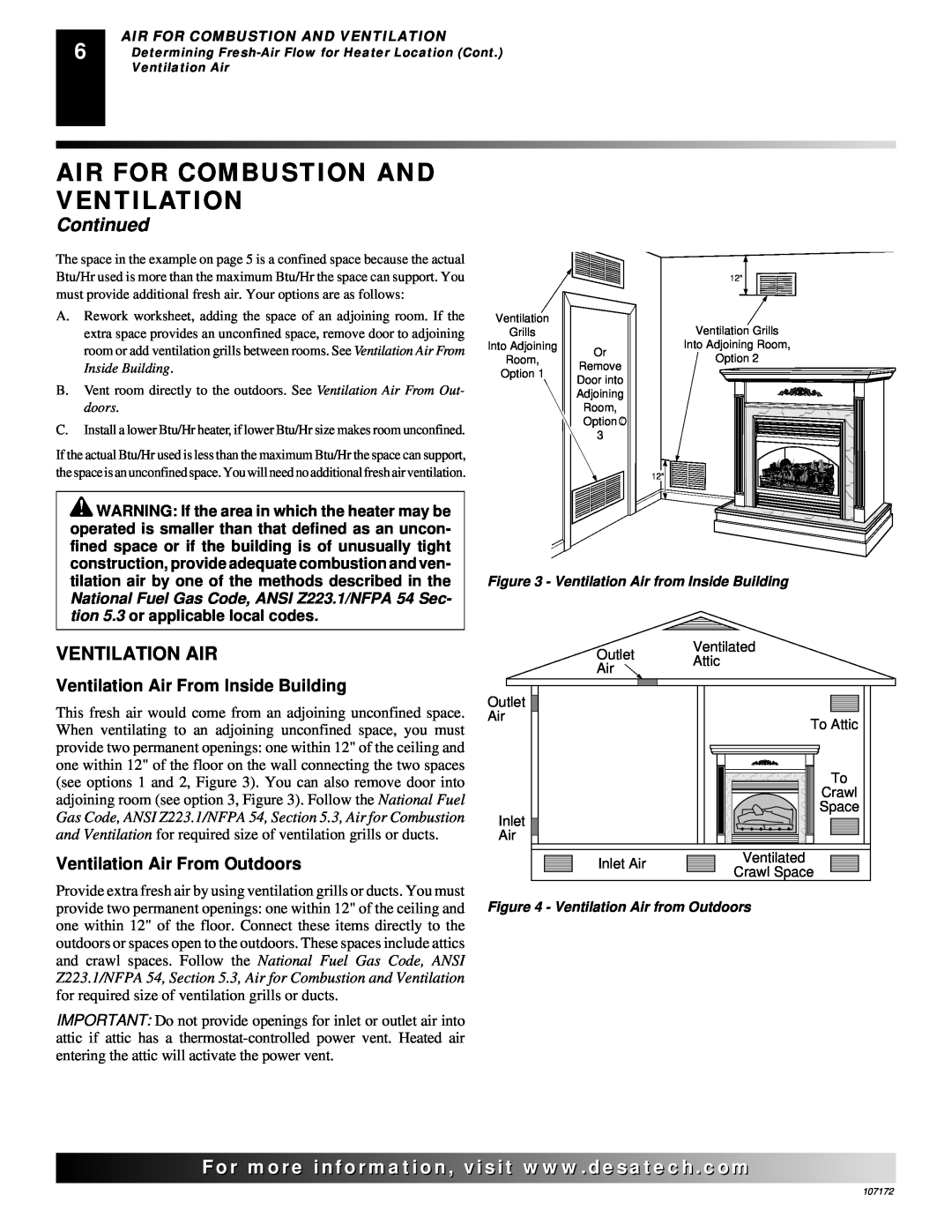Do not try to light any appliance
OWNER’S OPERATION AND INSTALLATION MANUAL
WHAT TO DO IF YOU SMELL GAS
UNVENTED VENT-FREEGAS FIREPLACE
TABLE OF CONTENTS
SAFETY INFORMATION
WARNINGS
PRODUCT IDENTIFICATION
Continued
SAFETY INFORMATION
SAFETY DEVICE
PRODUCT FEATURES
OPTIONAL REMOTE CONTROL ACCESSORY
OPTIONAL BLOWER ASSEMBLY ACCESSORY
Unusually Tight Construction
PROVIDING ADEQUATE VENTILATION
DETERMINING FRESH-AIRFLOW FOR HEATER LOCATION
Confined and Unconfined Space
Ventilation Air From Outdoors
VENTILATION AIR
Ventilation Air From Inside Building
AIR FOR COMBUSTION AND VENTILATION
Blower Accessories, and GA3555 Internal
INSTALLATION
INSTALLING HOOD
CHECK GAS TYPE
Included with Mantel Accessory
INSTALLATION CLEARANCES
CONVENTIONAL FIREPLACE INSTALLATION
ASSEMBLING AND ATTACHING OPTIONAL BRASS TRIM
Access
INSTALLATION
INSTALLATION
Figure 10 - Installing Cabinet Mantel
INSTALLATION
BUILT-INFIREPLACE INSTALLATION
Mantel Clearances for Built-InInstallation
Continued
INSTALLATION
INSTALLING GAS PIPING TO FIREPLACE LOCATION
Installation Items Needed
Continued
Continued
INSTALLATION
Installation Items Needed
5/16 hex socket wrench or nut-driver
CHECKING GAS CONNECTIONS
Pressure Testing gas Supply Piping system
Pressure Testing Fireplace Gas Connections
INSTALLATION
INSTALLING LOGS
INSTALLATION
Continued
LIGHTING INSTRUCTIONS
FOR YOUR SAFETY READ BEFORE LIGHTING
OPERATING FIREPLACE
INSTALLATION
OPTIONAL REMOTE OPERATION
MANUAL LIGHTING PROCEDURE
TO TURN OFF GAS TO APPLIANCE
Shutting Off Heater
OPERATING FIREPLACE
OPTIONAL BLOWER OPERATION
GHRCTA Series Operation
Continued
FRONT BURNER FLAME PATTERN
INSPECTING BURNERS
PILOT FLAME PATTERN
MAIN BURNER
CLEANING AND MAINTENANCE
LOGS
POSSIBLE CAUSE
TROUBLESHOOTING
OBSERVED PROBLEM
REMEDY
TROUBLESHOOTING
Maintenance, page
Refer to Air for Combustion and Venti
OBSERVED PROBLEM
TROUBLESHOOTING
visit
ing Gas Connections, page
OBSERVED PROBLEM
REPLACEMENT PARTS
WIRING DIAGRAM
SPECIFICATIONS
SERVICE HINTS
EFS33PR, VSGF33PR Shown
LOG BASE ASSEMBLY EFS33NR, VSGF33NR4
ILLUSTRATED PARTS BREAKDOWN
Log Base Assembly
PART NUMBER
PARTS LIST
PARTS LIST
EFS33NR
ILLUSTRATED PARTS BREAKDOWN
FIREPLACE17 EFS33NR,VSGF33NR EFS33PR, VSGF33PR
ILLUSTRATED PARTS BREAKDOWN
Fireplace
PARTS LIST
FIREPLACE EFS33NR, VSGF33NR EFS33PR, VSGF33PR
PARTS LIST
PART NUMBER
EQUIPMENT SHUTOFF VALVE - GA5010
ACCESSORIES
BLOWER ACCESSORY GA3700 & GA3700T SERIES
DUPLEX OUTLET KIT - GA3555 Not Shown
CORNER HEARTH BASE
BRASS TRIM ACCESSORY - GA7090 Not Shown
CLEANING KIT - GCK Not Shown
HARDWOOD HEARTH BASE
GHRCTA SERIES
WALL-MOUNTTHERMOSTAT SWITCH - GWMT1
WALL-MOUNTON/OFF SWITCH - GWMS2
Not Shown
OWNERS REGISTRATION FORM
Postage Required
2701 Industrial Drive P.O. Box Bowling Green, KY
Page
NOT A UPC
KEEP THIS WARRANTY
LIMITED WARRANTY VENT-FREEGAS FIREPLACE
Model Serial No Date Purchased
